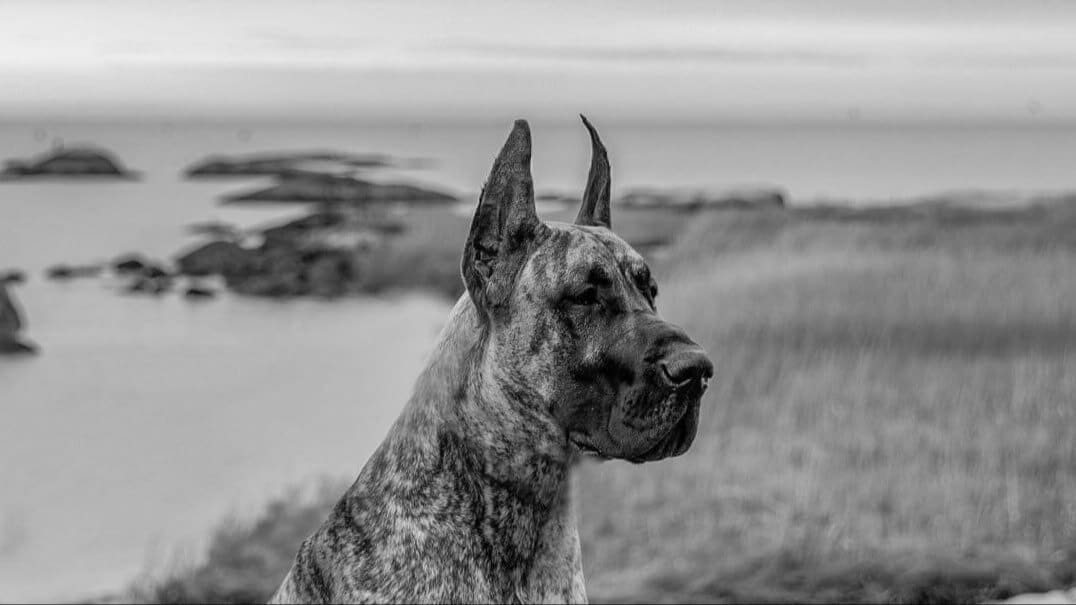
Melissa Dreyer & Pat Haltmeier | Haltmeier Kennel N Sunrise
Preservation breeders Dreyer & Haltmeier share their passion for Great Danes, breed integrity, public outreach, and dog show trends.

Home » Meet The Breeds » Great Dane

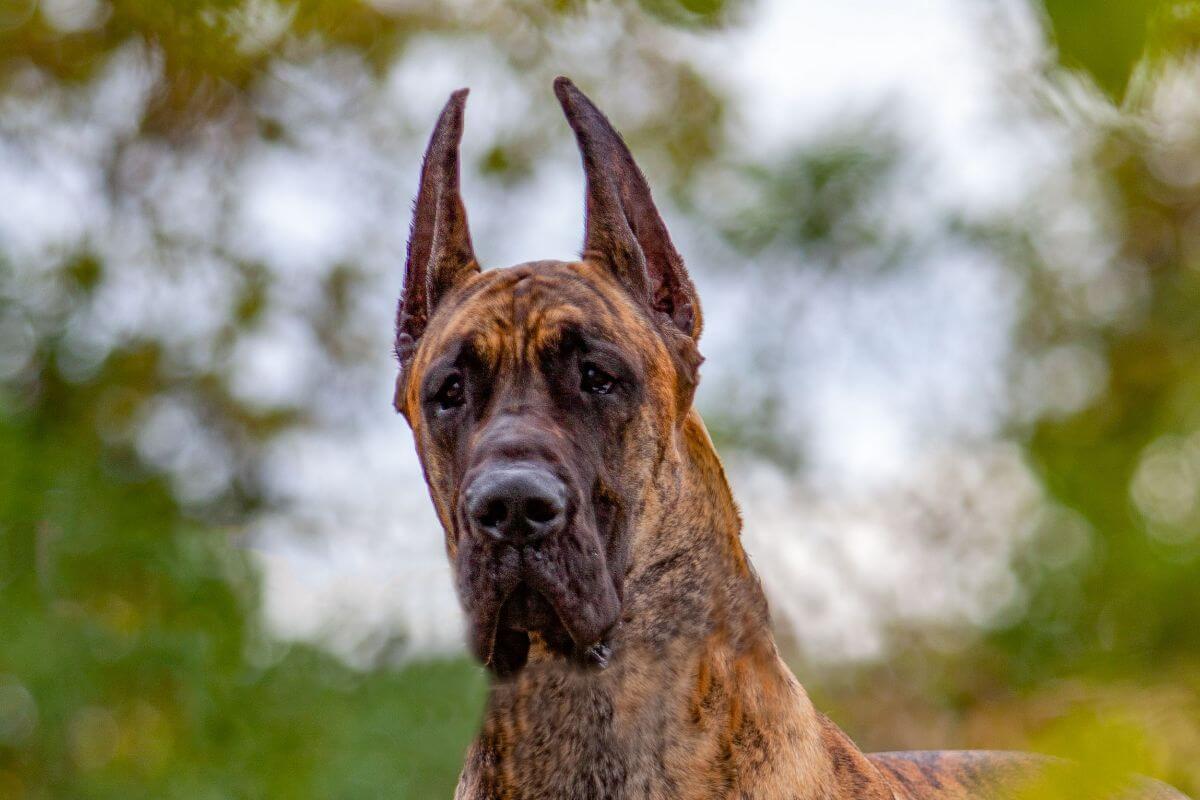
The Great Dane, often called the “Apollo of Dogs,” is one of the tallest and most dignified of all breeds. Known for its majestic stature and noble expression, the “Dane” combines strength with an affectionate and loyal temperament. Originally bred for hunting large game animals such as bear and wild boar, the breed today is a devoted companion that excels as a dependable watchdog and family companion.
Working
28 – 32 inches
110 – 175 pounds
7 – 10 years
| Country of Origin | Germany |
|---|---|
| Bred For | Boar Hunting |
| Known For | Friendliness, Great Size, Regal Appearance |
| Popularity | High |
| Temperament | Courageous, Dependable, Friendly, Spirited |
| Activities | Walking, Conformation Shows, Dog Sports |
The Great Dane’s origins trace back thousands of years, with early depictions of similar dogs appearing in ancient Egyptian, Greek, and Roman art. Large mastiff-type dogs were commonly used in Medieval Europe for hunting and guarding, but the breed as it is known today was developed primarily in Germany.
By the 16th century, European nobility selectively bred these powerful dogs to hunt wild boars, bears, and other formidable prey. These early Great Danes were called “Boar Hounds” due to their primary function as hunters. German breeders refined the dog further, selecting for both size and temperament, resulting in a breed that was not only a skilled hunter but also a loyal household guardian.
By the late 19th century, the breed’s role had shifted from hunting to that of a companion and estate guardian. In 1876, Germany officially named the breed “Deutsche Dogge” (German Mastiff), a name still used in some parts of the world today. However, English-speaking countries have referred to the breed as the “Great Dane,” a name that originated from the French naturalist Georges-Louis Leclerc, Comte de Buffon, who mistakenly associated the breed with Denmark.
The Great Dane gained international recognition when the breed was exhibited at European dog shows in the late 1800s. The American Kennel Club (AKC) officially recognized the breed in 1887, making it one of the earliest breeds accepted by the organization. The breed is also recognized by the Fédération Cynologique Internationale (FCI) and The Kennel Club (UK), among other registries worldwide.
Adult male Great Danes stand at a minimum of 30 inches tall at the shoulder, though many reach 32 inches or more. Mature females are typically shorter, with a minimum height of 28 inches, though often exceeding 30 inches.
Males generally weigh between 140 and 175 pounds, while females are usually lighter, ranging from 110 to 140 pounds.
The Great Dane has a square silhouette in profile, though females may be somewhat longer in body. The breed is muscular and strong without being bulky or clumsy. Males should appear more substantial than females, which are slightly more refined. Maintaining proper substance is essential, as excess weight or weak construction can impact both health and mobility.
A broad and deep chest extends to the elbows, with well-sprung ribs that are not barrel-shaped. The back is level and firm, leading to a slightly arched loin and a broad and very slightly sloping croup. Well-angulated forequarters and hindquarters ensure easy and efficient movement and balance.
Texture: The Great Dane has a short, smooth, and dense coat that lies close to the body. The texture is fine yet strong, providing a sleek, glossy appearance. The coat offers some protection from the elements but is not suited for extreme weather conditions. Grooming needs are minimal.
Colors:
Markings:
A Note About Color: The Great Dane has seven recognized coat colors, either solid-colored or with specific patterns and markings. Brindle is a yellow-gold base color with black cross stripes in a chevron pattern and a black mask. Black should appear on the eye rims and eyebrows and may appear on the ears and tail tip. Fawn is yellow-gold in color with a black mask. Black should appear on the eye rims and eyebrows and may appear on the ears and tail tip. Blue is a pure steel blue. White markings on the chest or toes are undesirable. Black is a glossy black. White markings on the chest or toes are undesirable. Harlequin is white with black torn patches well distributed over the body, with a whole or partial white neck. Merle patches are normal and black pigment may be seen on the skin in white areas. Mantle is black and white with a black blanket extending over the body. The skull is black with an optional white blaze. The neck is white, in whole or in part, as is the chest and the tip of the tail. The forelegs and hind legs are also white, in whole or in part. A small white break in the blanket is acceptable, and black pigment may be seen on the skin in white areas. Merle is a pale gray to dark gray base color with black torn patches within. It may be solid or with a Mantle pattern. A “Merlequin,” a white dog with only patches of Merle, is a disqualification in the show ring as is any color other than the seven described.
The Great Dane’s tail is long, set high, and reaches the hock joint when relaxed. It is set high and smoothly into the croup, and tapers toward the tip. It should be neither excessively thick nor thin. When in motion, the tail is carried with a natural curve but does not curl over the back. It may have a slight upward lift when the dog is excited or alert, but a tightly curled ring tail or a hooked tail is a serious fault. A docked tail is a disqualification in the show ring.
Owning a Great Dane comes with unique challenges and responsibilities due to the breed’s massive size and specific health concerns, and the need for proper training and socialization. While the Dane is affectionate and gentle, its large frame requires careful management in both the home and in public settings.
The Great Dane has a relatively short lifespan of 7 to 10 years, with its large size contributing to a few health concerns. As a giant breed, it requires proactive veterinary care to monitor potential joint, heart, and digestive issues. Controlled nutrition and moderate exercise play key roles in maintaining long-term health.
Great Danes may be susceptible to several health conditions, including:
Great Danes are affectionate, loyal, and gentle despite their imposing size. They form strong bonds with their human companions and thrive on companionship, making them unsuitable for prolonged periods of isolation. While generally well-mannered and patient, they can be sensitive and may not respond well to harsh training methods.
Their friendly nature typically makes them good with children, though their size requires supervision around small kids to prevent accidents. Danes usually get along well with other dogs and can coexist peacefully with smaller pets if properly socialized. While friendly toward strangers, they can be protective when necessary, making them natural watchdogs. Their intelligence and eagerness to please contribute to their trainability, but early socialization and consistent training are essential to prevent unwanted behaviors.
Great Danes require a carefully regulated diet to support their large frame and prevent health issues.
Puppies must be fed a large-breed puppy formula designed for slow, controlled growth to reduce the risk of joint and bone disorders. Overfeeding or excess protein can lead to skeletal problems.
Adult Great Danes typically eat 6 to 10 cups of dry food per day, divided into at least two meals to prevent bloat (GDV). Portion size should vary based on age, activity level, and metabolism. Free-feeding is discouraged to avoid obesity.
Water should always be available, and some owners use elevated food bowls, though their effectiveness in preventing bloat remains debated. Consultations with a dog’s breeder and veterinarian are recommended for individualized feeding plans.
Great Danes are intelligent and eager to please, but they require firm and consistent training due to their large size. Positive reinforcement methods, such as treats and praise, work best, as the breed can be sensitive to harsh corrections. Early socialization is crucial to prevent timidity or overprotectiveness.
The Dane’s size makes leash training essential from an early age to prevent pulling and ensure manageable walks. While not prone to excessive barking, some dogs will vocalize to alert their owners of unfamiliar activity. A moderate prey drive can encourage individuals to chase smaller animals if not trained to control these impulses.
Obedience training is highly recommended to establish good manners, as an untrained Great Dane can be difficult to manage due to its physical strength. Teaching basic commands such as “sit,” “stay,” and “heel” from an early age helps to ensure the dog grows into a well-behaved adult. Mental stimulation through interactive toys and training exercises is beneficial to keep the Dane engaged and prevent boredom-related behaviors.
Great Danes have moderate exercise needs, requiring daily walks and space to move around freely. While they are not high-energy dogs, regular activity is essential to maintain muscle tone and prevent obesity.
| Energy Level | Moderate to High |
|---|---|
| Exercise Requirements | 1 Hour/Day (Minimum), Daily Walks, Regular Exercise, Mental Stimulation |
Puppies should avoid excessive running, jumping, or stair climbing, as their fast-growing bones and joints can be prone to injury. Controlled exercise, such as leash walks and play in a fenced area, is ideal.
Adult Great Danes benefit from brisk walks, off-leash play in enclosed spaces, and interactive activities. They are not built for endurance sports and should avoid strenuous exercise, especially before or after meals.
Mental engagement, such as training sessions and puzzle toys, helps to prevent boredom-related behaviors that can lead to damage or injury..
Great Danes have a short, smooth coat that is easy to maintain. Regular brushing with a rubber curry brush or bristle brush helps to reduce shedding and keeps the coat healthy. While they are moderate shedders, seasonal shedding increases during certain times of the year.
| Coat Type | Short, Thick, Glossy, Smooth |
|---|---|
| Grooming Requirements | Weekly Brushing, Occasional Bathing, Routine Ear Cleaning, Periodic Nail Trimming, Regular Tooth Brushing |
Bathing is only necessary as needed, typically every few months unless the dog gets particularly dirty. The large ears should be checked and cleaned regularly to prevent wax buildup and infections, and nail trimming is essential, as overgrown nails can cause discomfort and affect movement.
Due to their somewhat droopy jowls, Great Danes can drool, especially after mealtime and drinking water. Regular cleaning of the face and wiping the mouth can be helpful. Dental care is also important, and regular brushing or dental chews will help to maintain good oral health.
Great Danes can adapt to various living situations, but their large size requires ample space. While they can live in apartments if properly exercised, they are best suited to homes with room to move about comfortably. Their long legs and tails can easily knock over furniture or objects in smaller spaces.
Danes are not well-suited for extreme weather conditions due to their short coat. In colder climates, they require warm shelter and may benefit from a dog coat or sweater. In warmer weather, they should avoid excessive heat exposure and have access to shade and fresh water at all times.
Despite their size, Great Danes crave human companionship and prefer to be indoors with their family. They are not well-suited to being left alone for long periods, as they thrive on interaction. Their gentle nature makes them excellent housedogs, but their large frame requires consideration in homes with small children, elderly individuals, or fragile pets.
Great Dane puppies grow rapidly, reaching full size by 18 months and filling out through their second and third years. Their large size and fast growth require a balanced diet, controlled exercise, and early training to ensure healthy development. Proper socialization is also crucial to prevent shyness or overprotectiveness.
The Great Dane puppy requires specialized care due to its rapid growth. The pup should be fed a high-quality large-breed puppy formula, with meals divided into three to four portions per day to prevent bloat and digestive issues. Overfeeding should be avoided to reduce the risk of skeletal disorders.
Exercise should be gentle and controlled, avoiding long-distance running and excessive stair climbing that can harm developing joints. Short walks and supervised play sessions are recommended.
Early training and socialization are essential. Basic obedience, leash training, and crate training should begin early to ensure good manners before the puppy becomes too large to handle. Positive reinforcement works best, as Great Danes are sensitive to harsh corrections.
Regular veterinary check-ups, vaccinations, and parasite prevention are necessary to ensure healthy growth and development.
The Great Dane is recognized by the world’s leading registries and kennel organizations, which categorize the breed into a specific Group based on its unique characteristics. This breed is recognized worldwide under the following Group designations:
| Organization | Group Designation |
|---|---|
| AKC (American Kennel Club) | Working |
| UKC (United Kennel Club) | Guardian |
| CKC (Canadian Kennel Club) | Working |
| ANKC (Australian National Kennel Council) | Non Sporting |
| RKC (The Royal Kennel Club) | Working |
| FCI (Fédération Cynologique Internationale) | Group 2: Pinscher and Schnauzer Molossoid Breeds – Swiss Mountain and Cattle Dogs; Section 2.1.: Molossoid Breeds, Mastiff Type |
The ideal Great Dane is described by a Breed Standard that is approved by each of the world’s leading registries and kennel organizations. The Breed Standards for this breed may be found in the following links:
| Organization | Breed Standard |
|---|---|
| American Kennel Club | AKC Great Dane Breed Standard |
| United Kennel Club | UKC Great Dane Breed Standard |
| Canadian Kennel Club | CKC Great Dane Breed Standard |
| Australian National Kennel Council | ANKC Great Dane Breed Standard |
| The Royal Kennel Club | RKC Great Dane Breed Standard |
| Fédération Cynologique Internationale | FCI Great Dane Breed Standard |
Great Dane rescue groups are dedicated to rehabilitating and rehoming dogs in need. These organizations rescue Danes from shelters, owner surrenders, and neglect situations, providing medical care, training, and foster homes until permanent placements can be made.
Great Danes have an average life expectancy of 7 to 10 years. This shorter lifespan, not uncommon in larger dogs, emphasizes the need for attentive care, including a proper diet, regular veterinary visits, and moderate exercise.
Great Danes are known for their impressive stature, ranking among the tallest of all dog breeds. Males typically stand 30 to 32 inches tall at the shoulder, while females range from 28 to 30 inches tall. Their height, coupled with a well-proportioned body, contributes to the breed’s majestic appearance.
Great Danes do shed, but due to their short coat the shedding is less intense compared to many long-haired breeds. Regular brushing, about once a week, helps to remove loose hair and maintains the coat’s luster.
Originally bred for hunting large game like wild boar, the Great Dane was valued for its strength and endurance. Danes were also used for guarding estates, their intimidating size making them effective protectors. Over time, they became more popular as companions known for their gentle nature.
Ear cropping in Great Danes has historical roots in practicality, believed to prevent injury during hunts and to protect against ear infections. However, in modern times, this practice is typically done for aesthetic as well as historical reasons.
Great Danes are often admired for their gentle, patient, and protective nature, making them typically excellent with children. Due to their large size, however, it’s important to supervise all interactions with younger children to avoid accidental bumps or knocks.
Scooby-Doo, the iconic character from the animated TV series, is a Great Dane. His depiction, with a large, lanky frame and a friendly, slightly goofy demeanor, captures some key characteristics of the breed. Scooby-Doo’s popularity has helped to raise awareness and affection for the breed worldwide.
The term “heartbreak breed” for Great Danes stems from their relatively short lifespan. Losing a pet is always difficult, but the loss of a Dane can be particularly impactful due to the breed’s affectionate and loyal nature. Their endearing personality makes their absence deeply felt.
Great Danes, despite their size, are not typically combative, making them less suitable as traditional guard dogs. However, their loyalty and protective instinct can make them effective watchdogs. They are most likely to alert their owners to strangers or unusual situations without becoming combative.
Great Danes experience rapid growth during their first year and typically reach their full size by about 18 months of age. However, they continue to develop in terms of muscle and bulk until they are about 2-3 years old. Proper nutrition and exercise during this growth period are crucial for their health.
Great Danes are not typically aggressive. They are renowned for their gentle, affectionate nature and tend to be friendly and sociable. It’s important to provide proper socialization and training from a young age to help them develop good behavior.
No, Great Danes are not considered hypoallergenic. They shed hair and dander, which is a common allergen for many people. Regular grooming can help to minimize dander but the breed may not be the best choice for individuals with severe allergies.
Despite their large size, Great Danes are capable of reaching impressive speeds. They can sprint up to about 30 miles per hour in short bursts, showcasing their agility and strength. This speed is a remnant of the breed’s hunting heritage.
Great Danes are known for their intelligence. They can learn commands and routines quickly, making them responsive to training. However, they can sometimes display a stubborn streak, so patience and consistency are key in their training.
Great Danes are known to drool, especially after drinking water or in anticipation of food. This drooling can be more pronounced in some individuals than others. Keeping a cloth handy can be helpful.
Great Danes are generally easy to train, thanks to their intelligence and eagerness to please, and they respond well to positive reinforcement techniques. Given the breed’s large size, it’s important to begin training early, focusing on consistency and a training approach that is firm yet fair.
With proper socialization and early exposure, Great Danes can coexist peacefully with cats. The breed’s gentle demeanor often allows these gentle giants to get along well with other household pets.
Great Danes can be protective of their family and home. They are often alert and aware of their surroundings, and their loyalty can make them cautious in new situations. Despite the Dane’s size, these dogs typically do not show aggression without cause.
Great Danes can make excellent family dogs, renowned for their loving and gentle nature. They often form strong bonds with family members; however, their considerable size makes it important to supervise all interactions with small children.
Despite the breed’s tremendous size, Great Danes can adapt well to apartment living. They are relatively calm indoors and do not require excessive space. However, they do need regular exercise and mental stimulation to stay healthy and happy.

Preservation breeders Dreyer & Haltmeier share their passion for Great Danes, breed integrity, public outreach, and dog show trends.
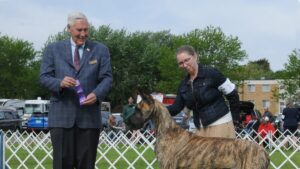
Sandy Mauck is the breeder behind BNB Danes, DiolaDanes & Hi-Class Danes. Read about the kennel’s beginnings, puppies, see photos & more!
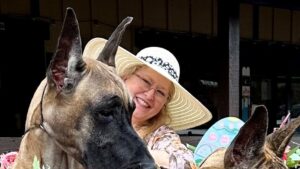
Paula Johnson is the breeder behind Rocky Creek Danes. Read about the kennel’s beginnings, the puppies, and much more!
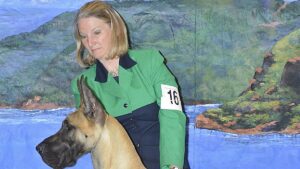
Katie Edwards is the breeder behind Laurado Kennels Great Danes. Read about the kennel’s beginnings, puppies, photos & more!
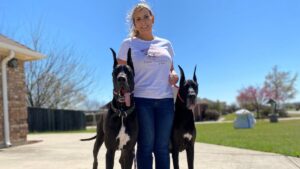
Discover insights from Great Dane breeders Melissa Dreyer and Pat Haltmeier on puppy selection, breed trends, and challenges in dog shows.
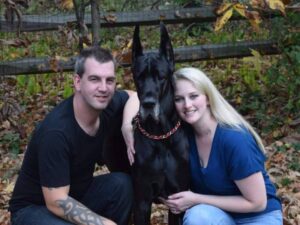
Jackie van Delft is breeder behind VanDelft Danes. Read about the kennel’s beginnings, the puppies, and much more!
The best way to ensure a long and happy relationship with a purebred dog is to purchase one from a responsible breeder. Not sure where to begin?
Contact the National Parent Club’s Breeder Referral Program, which is listed on the AKC Breeder Referral Contacts page.
